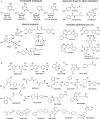Molecular modeling of inhibitors of human DNA methyltransferase with a crystal structure: discovery of a novel DNMT1 inhibitor
- PMID: 22607757
- PMCID: PMC3837394
- DOI: 10.1016/B978-0-12-398312-1.00008-1
Molecular modeling of inhibitors of human DNA methyltransferase with a crystal structure: discovery of a novel DNMT1 inhibitor
Abstract
DNA methyltransferases (DNMTs) are promising epigenetic targets for the development of novel anticancer drugs and other diseases. Molecular modeling and experimental approaches are being used to identify and develop inhibitors of human DNMTs. Most of the computational efforts conducted so far with DNMT1 employ homology models of the enzyme. Recently, a crystallographic structure of the methyltransferase domain of human DNMT1 bound to unmethylated DNA was published. Following on our previous computational and experimental studies with DNMTs, we herein present molecular dynamics of the crystal structure of human DNMT1. Docking studies of established DNMT1 inhibitors with the crystal structure gave rise to a structure-based pharmacophore model that suggests key interactions of the inhibitors with the catalytic binding site. Results had a good agreement with the docking and pharmacophore models previously developed using a homology model of the catalytic domain of DNMT1. The docking protocol was able to distinguish active DNMT1 inhibitors from, for example, experimentally known inactive DNMT1 inhibitors. As part of our efforts to identify novel inhibitors of DNMT1, we conducted the experimental characterization of aurintricarboxylic acid (ATA) that in preliminary docking studies showed promising activity. ATA had a submicromolar inhibition (IC(50)=0.68 μM) against DNMT1. ATA was also evaluated for Dnmt3a inhibition showing an IC(50)=1.4 μM. This chapter illustrates the synergy from integrating molecular modeling and experimental methods to further advance the discovery of novel candidates for epigenetic therapies.
Copyright © 2012 Elsevier Inc. All rights reserved.
Figures









Similar articles
-
Docking of a novel DNA methyltransferase inhibitor identified from high-throughput screening: insights to unveil inhibitors in chemical databases.Mol Divers. 2013 May;17(2):337-44. doi: 10.1007/s11030-013-9428-z. Epub 2013 Feb 28. Mol Divers. 2013. PMID: 23447100
-
Inhibitors of DNA methyltransferases: insights from computational studies.Curr Med Chem. 2012;19(21):3475-87. doi: 10.2174/092986712801323289. Curr Med Chem. 2012. PMID: 22709005 Review.
-
Trimethylaurintricarboxylic acid inhibits human DNA methyltransferase 1: insights from enzymatic and molecular modeling studies.J Mol Model. 2012 Apr;18(4):1583-9. doi: 10.1007/s00894-011-1191-4. Epub 2011 Jul 30. J Mol Model. 2012. PMID: 21805123 Free PMC article.
-
Homology modeling, docking and structure-based pharmacophore of inhibitors of DNA methyltransferase.J Comput Aided Mol Des. 2011 Jun;25(6):555-67. doi: 10.1007/s10822-011-9441-1. Epub 2011 Jun 10. J Comput Aided Mol Des. 2011. PMID: 21660514
-
Molecular modeling and virtual screening of DNA methyltransferase inhibitors.Curr Pharm Des. 2013;19(12):2138-47. doi: 10.2174/1381612811319120002. Curr Pharm Des. 2013. PMID: 23016844 Review.
Cited by
-
Expanding the Structural Diversity of DNA Methyltransferase Inhibitors.Pharmaceuticals (Basel). 2020 Dec 27;14(1):17. doi: 10.3390/ph14010017. Pharmaceuticals (Basel). 2020. PMID: 33375520 Free PMC article.
-
Specific Inhibition of DNMT3A/ISGF3γ Interaction Increases the Temozolomide Efficiency to Reduce Tumor Growth.Theranostics. 2016 Aug 25;6(11):1988-1999. doi: 10.7150/thno.9150. eCollection 2016. Theranostics. 2016. PMID: 27698935 Free PMC article.
-
Methylation of the Promoter Region of the Tight Junction Protein-1 by DNMT1 Induces EMT-like Features in Multiple Myeloma.Mol Ther Oncolytics. 2020 Oct 10;19:197-207. doi: 10.1016/j.omto.2020.10.004. eCollection 2020 Dec 16. Mol Ther Oncolytics. 2020. PMID: 33251332 Free PMC article.
-
Docking of a novel DNA methyltransferase inhibitor identified from high-throughput screening: insights to unveil inhibitors in chemical databases.Mol Divers. 2013 May;17(2):337-44. doi: 10.1007/s11030-013-9428-z. Epub 2013 Feb 28. Mol Divers. 2013. PMID: 23447100
-
Molecular modeling studies of the novel inhibitors of DNA methyltransferases SGI-1027 and CBC12: implications for the mechanism of inhibition of DNMTs.PLoS One. 2013 Apr 25;8(4):e62152. doi: 10.1371/journal.pone.0062152. Print 2013. PLoS One. 2013. PMID: 23637988 Free PMC article.
References
-
- Caulfield T., Medina-Franco J.L. Molecular dynamics simulations of human DNA methyltransferase 3B with selective inhibitor nanaomycin A. J. Struct. Biol. 2011;176:185–191. - PubMed
-
- Chen T.P., Hevi S., Gay F., Tsujimoto N., He T., Zhang B.L. Complete inactivation of DNMT1 leads to mitotic catastrophe in human cancer cells. Nat. Genet. 2007;39:391–396. - PubMed
Publication types
MeSH terms
Substances
Grants and funding
LinkOut - more resources
Full Text Sources
Molecular Biology Databases
Research Materials

